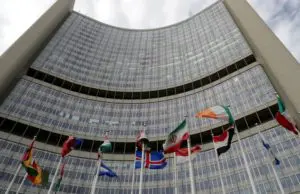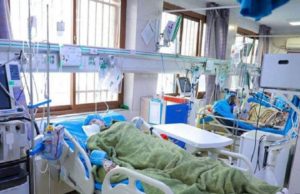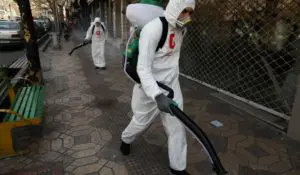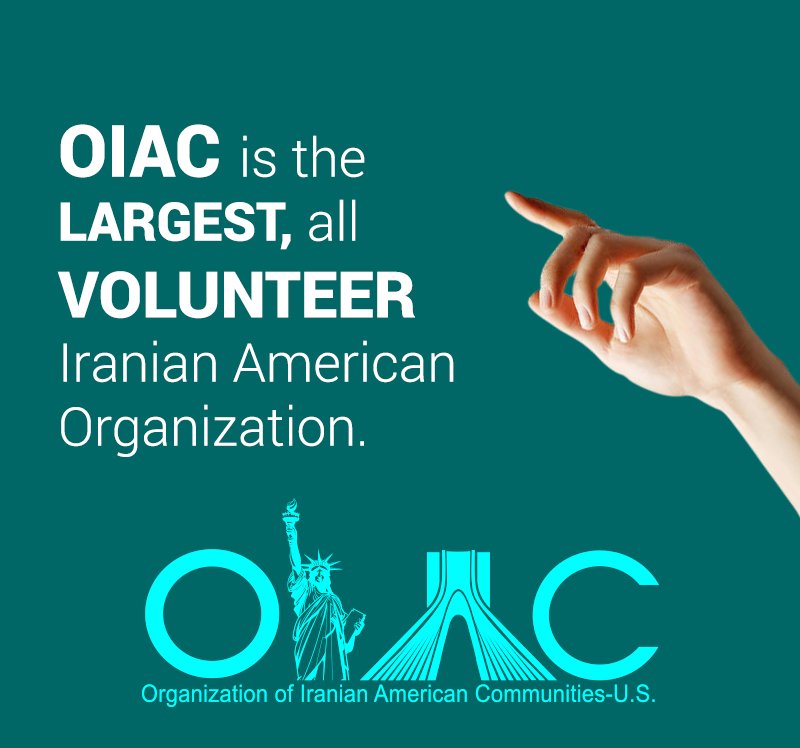How Iran’s Coronavirus outbreak began

Iran Has Far More Coronavirus Cases Than It Is Letting On
The surprising number of Iranian government officials succumbing to COVID-19 offers a hint that the disease is far more widespread than the official statistics indicate.
The Atlantic, March 9, 2020
You are standing before a huge barrel of apples. You can’t see the apples, but you can reach in and pick them out. Most are delicious, but a very small number of them are rotten—just about one in 12,000, your friend assures you. You reach in blindly and miraculously pick out a rotten apple. You reach in again and withdraw a whole heaping bushel of apples, maybe 50 in all. Most are good, but when you look closely you see them: one, two, three, four more rotten apples. One rotten apple is an amazing coincidence. Five means your barrel has lots of rotting apples in it and your friend was lying to you.
As of yesterday, according to Johns Hopkins University’s Coronavirus Resource Center, Iran has reported 6,566 COVID-19 cases, or about one in every 12,000 people in its population. The first case appeared on February 19. Right now Iran is third behind China (80,695) and South Korea (7,314), and just ahead of Italy (5,883). But the official Iranian number is almost certainly an undercount, probably due to the Iranian government’s attempt to hide a desperate situation for which it is partially responsible. When the final history of the coronavirus epidemic of 2020 is written, it may go something like this: The disease started in China, but it became finally and irrevocably uncontained in Iran. Knowing that the Iranian number is much higher than currently disclosed tells the rest of the world that the epidemic is even further along than official statistics indicate.
The first sign of dishonesty came on February 28, when Masoumeh Ebtekar, one of the country’s vice presidents, announced that she had the virus. Ebtekar is one of the most famous politicians in the country, well known even in the West for her role as a particularly sadistic member of the group that held U.S. diplomats hostage in 1979 in Tehran. Of course, being a notorious sociopath confers no immunity against COVID-19. But here is where the rotting apples come in.
If COVID-19 is so rare—fewer than 400 cases had been reported in Iran by the day she announced her diagnosis—what are the chances that one of the afflicted would be a famous politician? Soon we learned of three other senior officials who not only contracted the virus but were killed by it: Mohammad Mirmohammadi, a member of a senior advisory council to Iran’s supreme leader, and Hossein Sheikholeslam and Hadi Khosrowshahi, both former high-level diplomats. Mohammad Sadr, another member of the council, announced his infection last week, as did Ebtekar’s fellow cabinet member Reza Rahmani. Recently, the speaker of parliament said 23 of his fellow members of parliament had tested positive. Two of them, Mohammad Ali Ramezani (February 29) and Fatemeh Rehber (March 7), have died.
click to read more
U.N. nuclear watchdog admonishes Iran for denying access to two sites
Yahoo.com, March, 2020
VIENNA/PARIS (Reuters) – The U.N. watchdog policing Iran’s troubled nuclear deal with major powers admonished Tehran on Tuesday for failing to answer its questions about past nuclear activities at three sites and for denying it access to two of them.
Reuters first reported on Monday that the IAEA planned to issue a second report in addition to its regular quarterly update on Iran’s nuclear activities, rebuking Iran for less than full cooperation in general and for failing to grant U.N. inspectors access to one or more sites of interest.
The regular report showed Iran’s stockpile of low-enriched uranium nearly tripling since November to more than a tonne, as Tehran continues to breach key limits of its steadily eroding nuclear deal in response to renewed U.S. sanctions against it since Washington pulled out of the accord in May 2018.
The extraordinary second report delved into the International Atomic Energy Agency’s open questions and Iran’s denial of access to sites which two senior diplomats said are believed to have been active in the early 2000s.
“I judged it necessary to produce a second report because I thought the situation is serious enough to merit such a move on my part,” new IAEA chief Rafael Grossi, who took office in December, told Reuters in an interview in Paris.
The second confidential IAEA report to member states seen by Reuters said Iran has not provided access to the agency to two locations … and not engaged in substantive discussions to clarify agency questions related to possible undeclared nuclear material and nuclear-related activities.
“We have insisted and despite all our efforts we have not been able to get that, so the situation requires on my part such a step because what this means is that Iran is curtailing the ability of the agency to do its work,” he said, adding that he hoped Tehran would reverse course after the IAEA’s board meets next week in Vienna.
click to read more
Iran Hospitals Can’t Cope With Coronavirus
Iran Focus, March 6, 2020
Iranian hospitals are “underequipped and overcapacity” because of the coronavirus (COVID-19) outbreak and are finding it difficult to admit new patients, according to local reports. The Iranian government claims that the coronavirus has killed 107 people and infected 3,513, but the people and the National Council of Resistance (NCRI) are reporting that over 1,500 people have died and that in just one hospital in Rasht, 700 people have died.
Let’s look at some of the most recent reports that have come through.In Zanjan, at least four people who died of the coronavirus by Wednesday were buried in a cemetery, while another was taken to Sarmesakhlu Village.
While Shariati Hospital in Mashhad has reached full capacity and can only admit patients with severe respiratory and lung-related problems. Everyone else is being told to stay at home. Eight coronavirus patients died on Tuesday and a further 14 have died since.
In Milad Hospital (and many others) in Tehran, the medical staff lack disinfectants and necessary facilities for patients, which has led to at least six doctors and nurses in the hospital being infected.
Dr. Massoud Mardani, a member of Iran’s National Influenza Committee, said that “30 to 40 percent of Tehran’s population would be infected with COVID-19 by March 20”, but still the state-run media said that Tehran’s working hours would return to normal.
In Razi Hospital in Rasht, which is one of the worst-hit areas in Iran, a doctors’ meeting was recorded and released. In that meeting, they said that 28 patients died overnight, while 25 were hospitalized every day. Eleven of the hospital’s 12 wards are filled with coronavirus patients, which means about 170 people.
While Rasht’s Social Security Hospital has roughly 130 coronavirus patients and the private hospitals have around 40.
Shadnoush, the representative of the Ministry of Health in Gilan, said that hospitals were “witnessing painful days” and that some families had lost several relatives to the “cruel” coronavirus.
In Qom, which is the epicenter of the outbreak in Iran, the authorities canceled the Saturday closure of offices and banks, which had been announced just hours before and working hours were returned to normal.
Click to read more
Iran Protests & more




Iran’s shaky response to the coronavirus raises fears of escalating health crisis
The Washington Times, March 5, 2020
Amid a global panic over coronavirus epidemic, Iran has stood out as a particularly problematic case, health experts say, and the government’s shaky response is not inspiring confidence. At least 107 people have died from the virus, with over 3,000 others infected, state media announced Thursday. Uniquely, senior members of the theocratic regime and the national legislature have been infected, and many believe the government is covering up the true death toll from the outbreak.
Sources in local health and government offices within Iran suggest that over 1,000 people have died from the disease, as footage emerges of an overflow of bodies piling up in morgues. Most infections and deaths have been reported in the holy city of Qom, which is believed to be the epicenter of the infections in the country — but officials have yet to quarantine the area.
Despite deep clashes over Iran’s nuclear and security policies, the Trump administration has offered to help Tehran manage the response to the coronavirus breakout in the country, but officials in Washington say Iranian officials have not accepted the assistance.
“We’ve made offers to the Islamic Republic of Iran and we make clear to others around the world and the region that assistance, humanitarian assistance to push back against the coronavirus in Iran is something that the United States of America fully supports,” Secretary of State Mike Pompeo told the House Foreign Affairs Committee last week.
He explained that Iran’s “health care infrastructure is not robust, and to date their willingness to share information about what’s really going on inside of [Iran] has not been robust.”
Click to read more
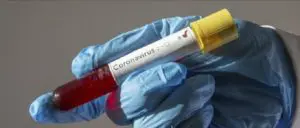
The Media Express, March 9, 2020
The history of the ayatollahs’ rule in Iran is synonymous with prompting crises abroad. Since the establishment of the Islamic Republic’s regime, Ruhollah Khomeini aligned the government’s apparatus in line with exporting terrorism and warmongering under the pretext of “exporting the revolution.” Now, Iran has become a major hub of exporting coronavirus to other countries.
In this context, the World Health Organization (WHO) and international news agencies identified Iran as the origin of coronavirus outbreak in regional states. Lebanon, Kuwait, Afghanistan, Armenia, Afghanistan, Iraq, and Turkey have since closed off their borders with Iran. Notably, the governments of Lebanon, Kuwait, UAE, and Canada announced that the Iranian passengers were the reason for the transfer of the virus in these countries. Also, after China, Iran is the second country with the highest death toll from the coronavirus.
Planned Crime and Bringing the Deadly Virus to Iran
No doubt, the rapid spread of coronavirus and consecutive victims in five days alone exposes that this virus had emerged in Iran long-time ago. However, the ayatollahs deterred from leaking its news and kept people in the dark. Now, ordinary people and even officials grasped that the government did not adopt any prevention move after the emergence of coronavirus in China.
In this instance, the Revolutionary Guards (IRGC)-owned Mahan airlines didn’t suspend its regular flights to China under the excuse of “cargo flights.” Therefore, the IRGC abused its potential for continuation of flights to the origin country of the virus, which makes this Khamenei-controlled force as the first responsible for carrying the virus to Iran.
The Main Reason for Surprising Death Toll in Iran
According to statistics and estimations of the WHO, the death ratio for coronavirus patients is two percent. In this regard, calculating the death toll in Iran reveals that the real number of people infected with the virus is much higher than the official numbers according to ballpark figures. Also, given the process of the virus, it shows that the highest officials of the government including Supreme Leader Ali Khamenei and President Hassan Rouhani were aware over the risks of the virus outbreak in the country.
The National Council of Resistance of Iran (NCRI) reported on Sunday 8 March: “ While the mullahs’ regime continues to cover up the number of Coronavirus fatalities, the People’s Mojahedin Organization of Iran (PMOI/MEK) announced that the death toll in 115 cities in 30 provinces had exceeded 2,300.”
“In the last 24 hours, more than 300 people in Tehran, Zahedan, Gonbad, Qom, Abadan, Saveh, Varamin, Qarchak, Shahr-e-ray, Kashan, Isfahan, Rasht, Hashtpar, Rezvanshahr, Astaneh, Mashhad, Kashmar, Birjand, Sari, Ghaemshahr and Babol lost their lives,” NCRI’s added in its report and continued:
Click to read more
Donation
501 (c)(3) Tax deductible
Please,
Donate to Organization Of Iranian American Communities
Your donation will help OIAC advocates for a democratic, secular and non-nuclear government in Iran. Founded on the respect for human rights, gender equality, religious and ethnic tolerance, as wells as social, economic justice, and security for America. Our goal is to organize Iranian-American communities in the United States to promote these values.
Thank You,
http://www.oiac-us.com/donation/


